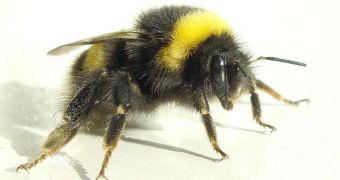A large portion of venomous animals, be they mammals, fish, reptiles or insects, are colored in bright hues, which alert potential predators to the dangers they may subject themselves to if they attack. Such is also the case with the bumblebee, which has a fairly strong type of venom. Admittedly not fatal in low doses, the mix can still inflict pain in humans, let alone in birds and other, smaller creatures. But a new study reveals that it's not just colors that make the bumblebee safe from predators. The research shows that the insect's flight patterns, sounds and shape may also influence predators, PhysOrg reports.
“The first time a bird eats a brightly colored bumblebee it gets a nasty surprise. Remembering the bee’s bright colors may help the bird to avoid making the same mistake again. We wanted to test the idea that bumblebee species in the same location converge on a similar appearance to enhance protection from local predators,” explains Royal Holloway School of Biological Sciences expert Dr Nigel Raine. Researchers from the University of London and Queen Mary, University of London also participated in the study, which is detailed in the May 26 issue of the esteemed scientific Journal of Zoology.
The investigation was carried out in Sardinia, Italy, Germany, and the United Kingdom. Researchers kept an eye on bumblebee population decline rates at these locations, and then compared the color patterns that the insects had on. Though the group expected to find that bumblebees colored differently from the rest would be eaten more often, this was not the case when the actual data came in. “Predators didn’t seem to target the unusually-colored bees from the non-native populations we tested. Perhaps the bumbling way in which all bumblebees fly, or their distinctive deep buzzing are more important clues to help would-be predators avoid a nasty sting,” Raine adds.
The experts found, however, that bumblebees all look the same in ultraviolet light. The tip of their Tails all reflect UV light strongly, and birds can easily pick up on those wavelengths, unlike humans. “Although birds can tell the difference between the color patterns of the different bee populations in our experiments, they probably find it hard to tell them apart in the fraction of a second when a bee flies past. Perhaps it’s better for the bird to steer clear of all animals which look, sound, or fly like a bumblebee to avoid the danger of eating one,” the researcher concludes.

 14 DAY TRIAL //
14 DAY TRIAL //